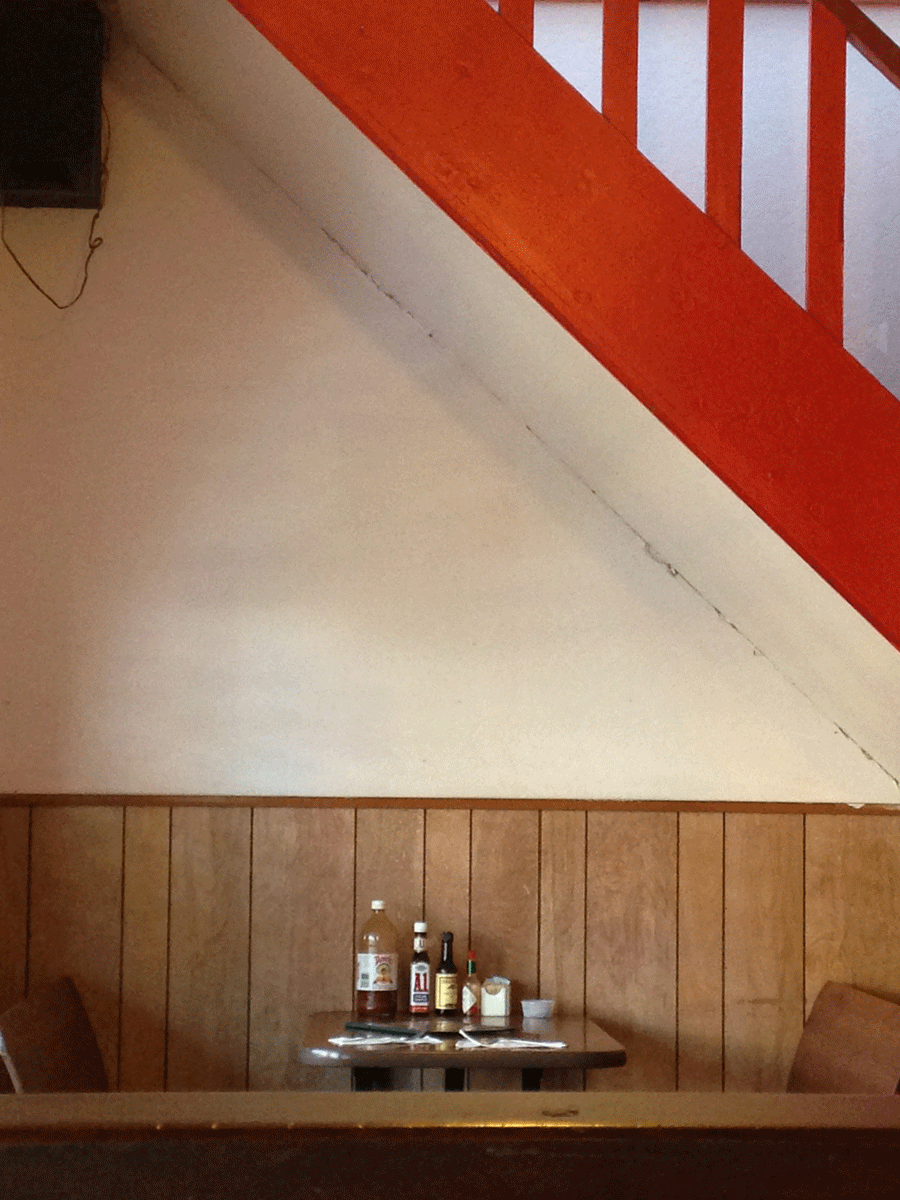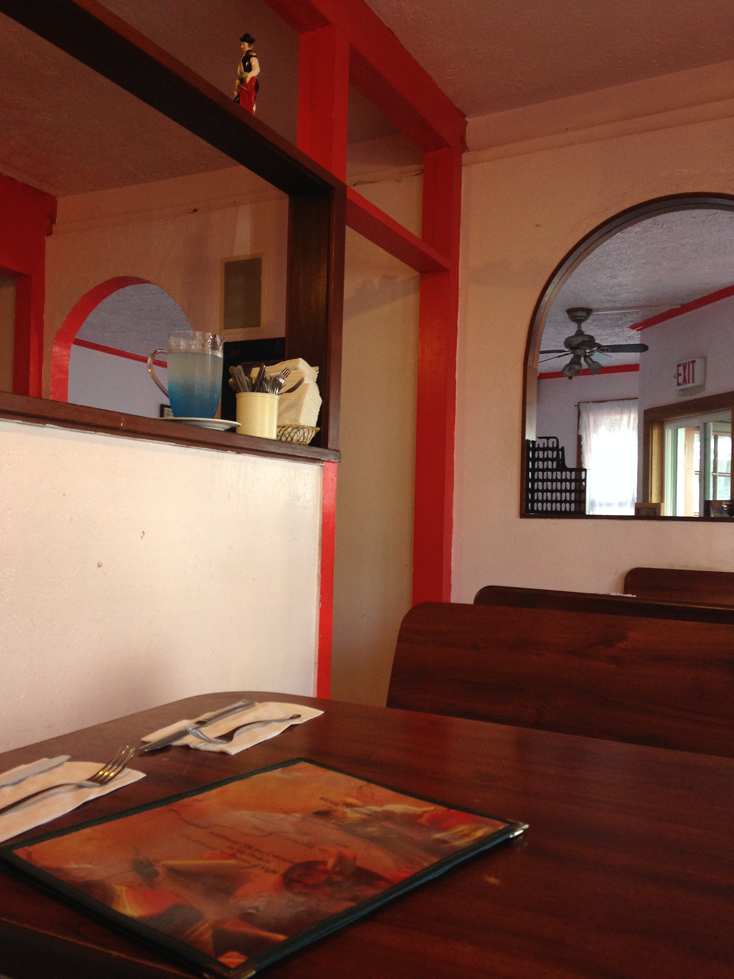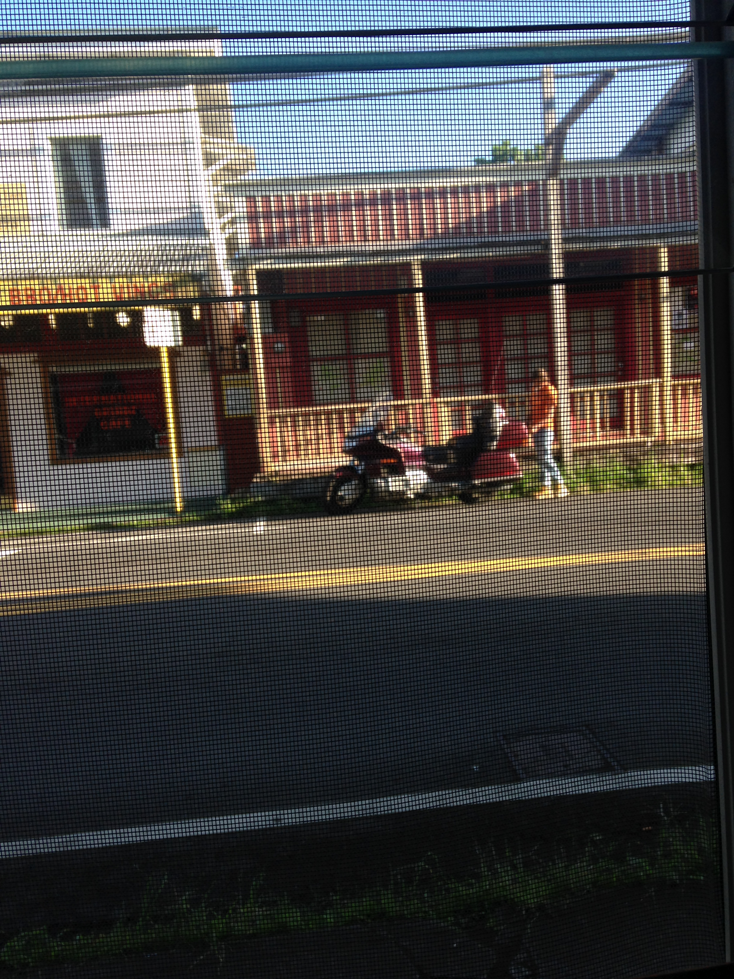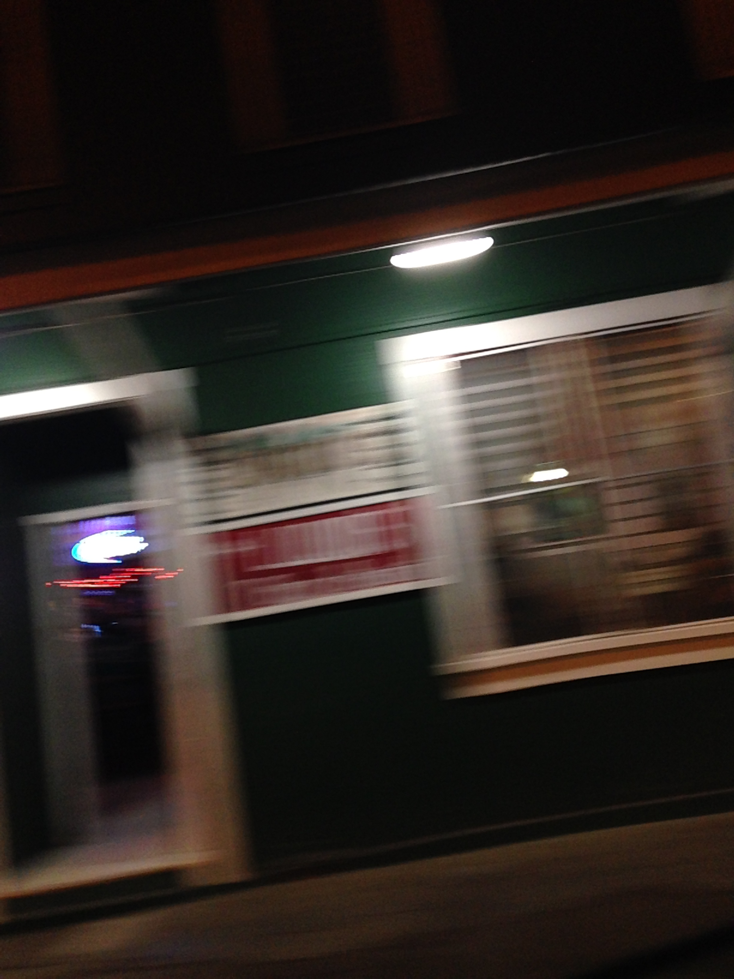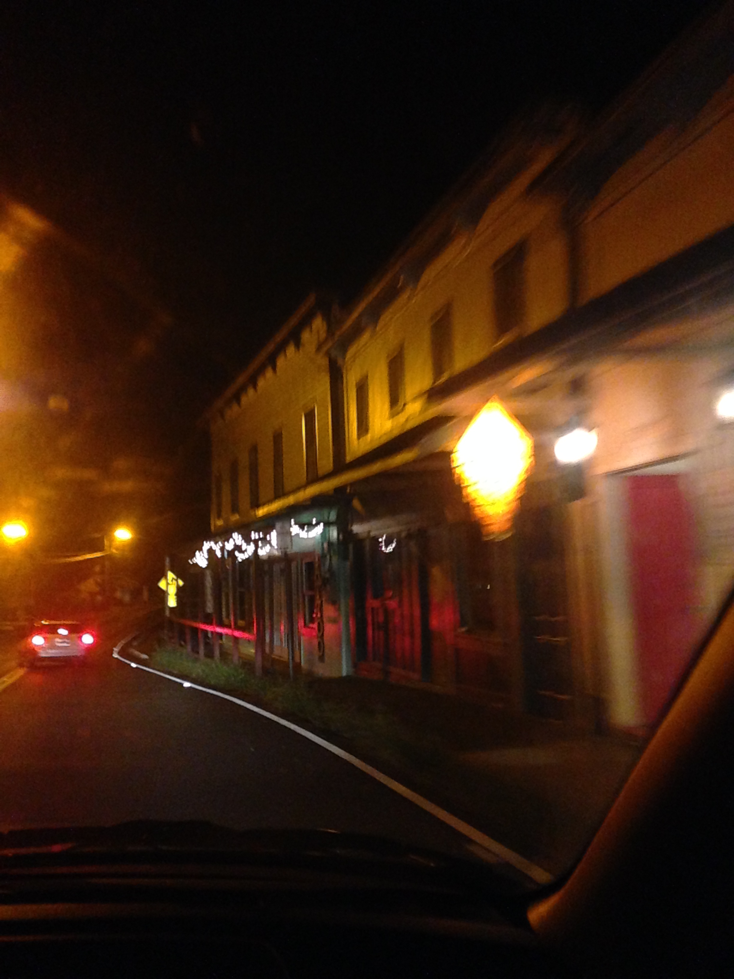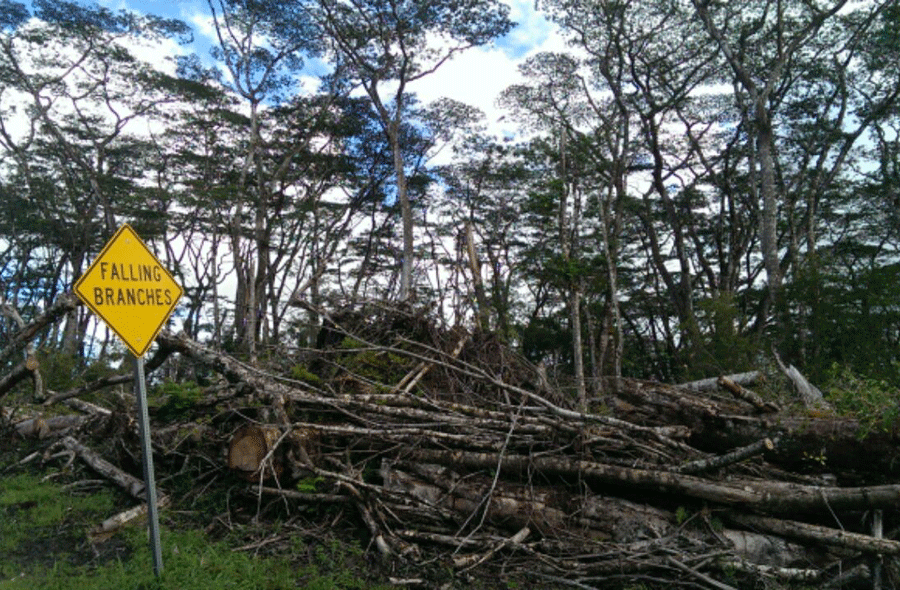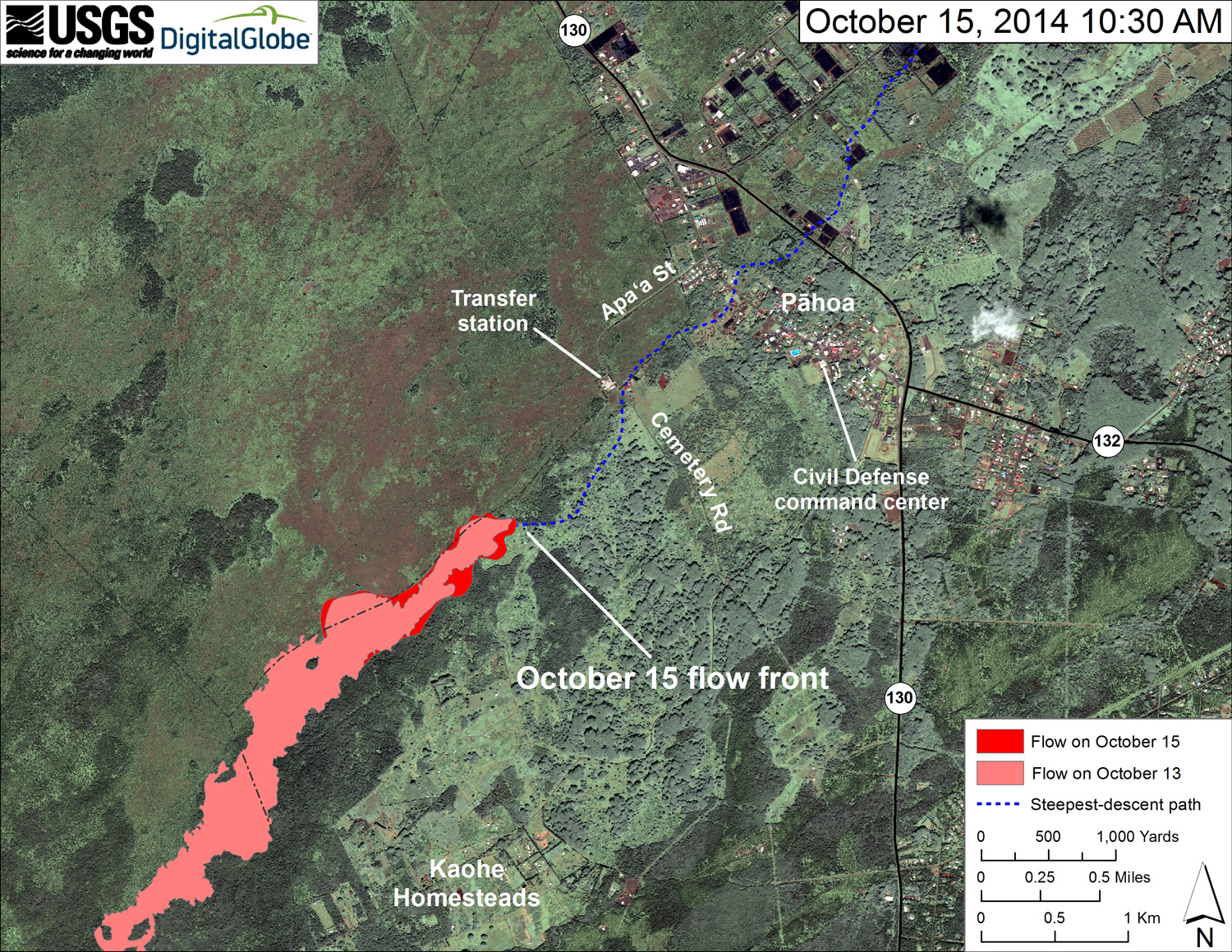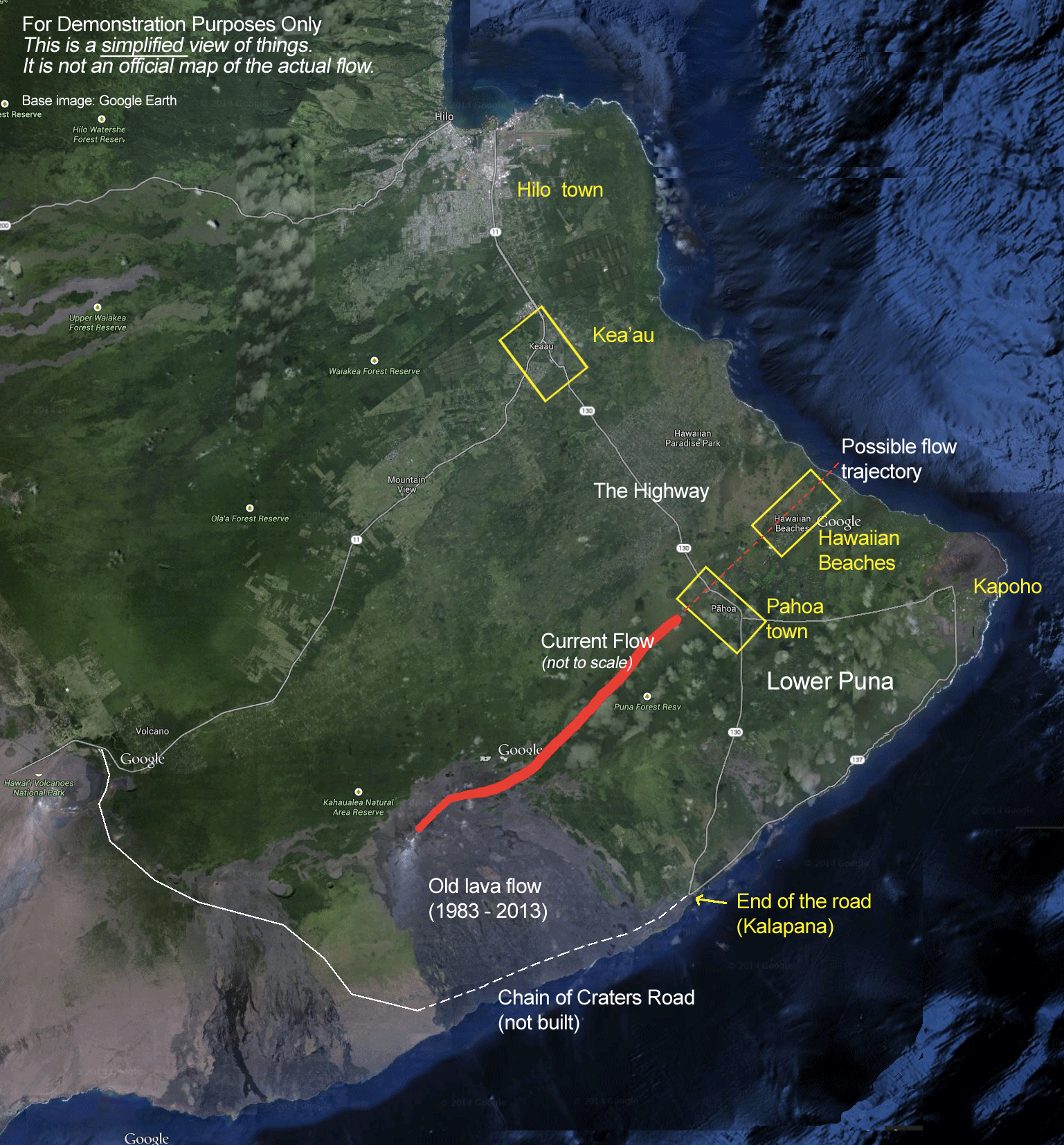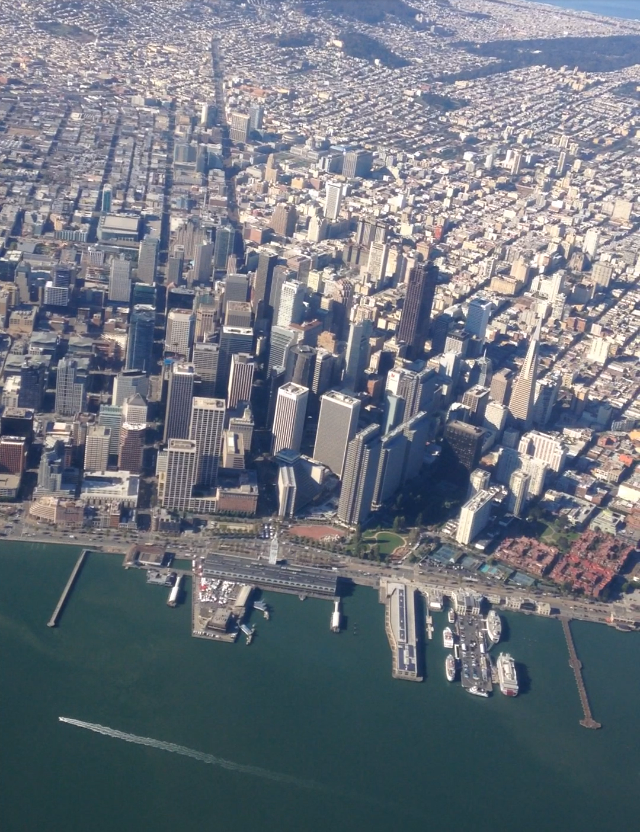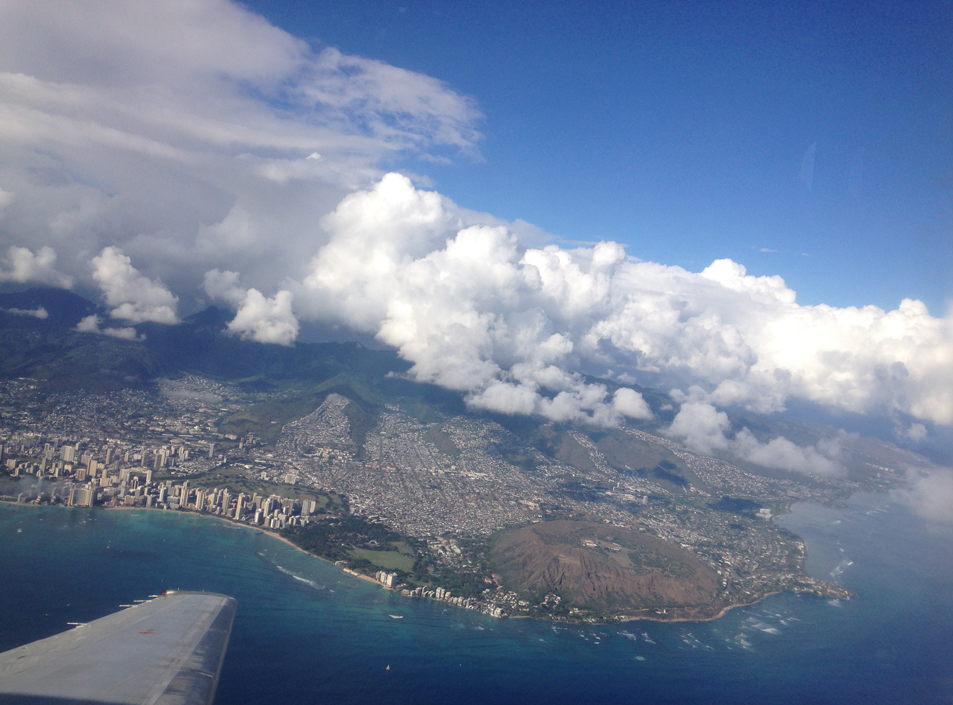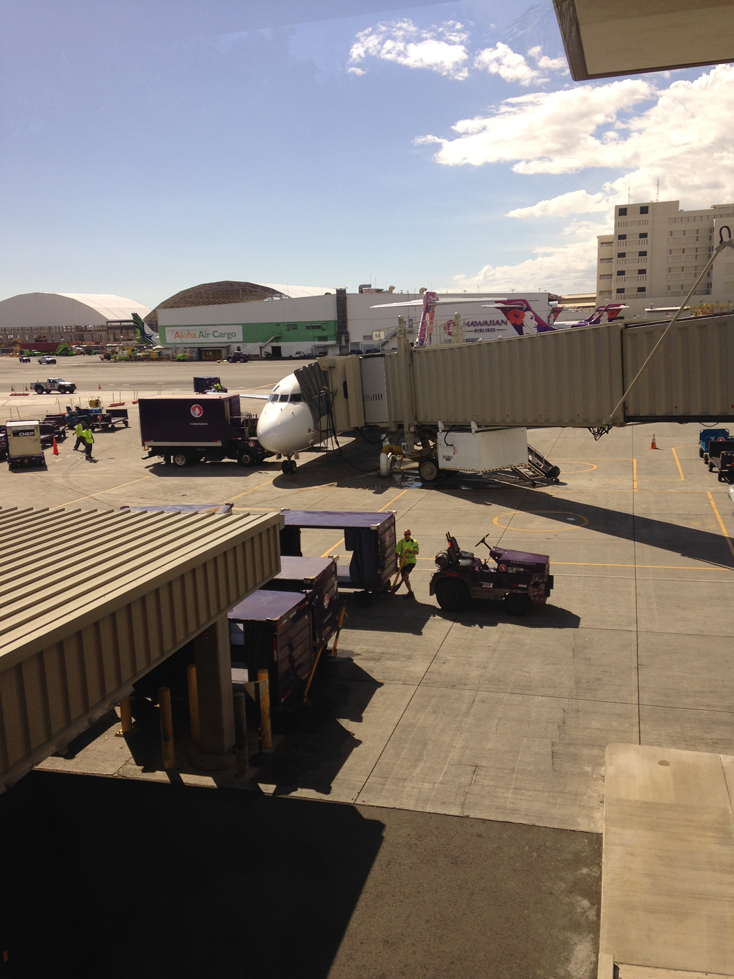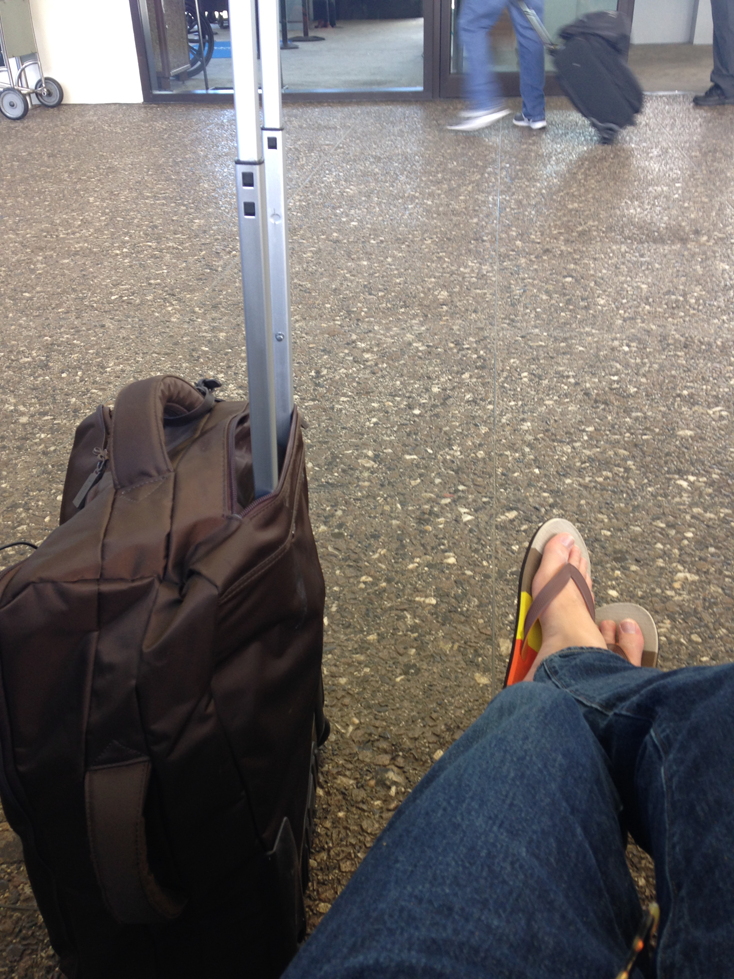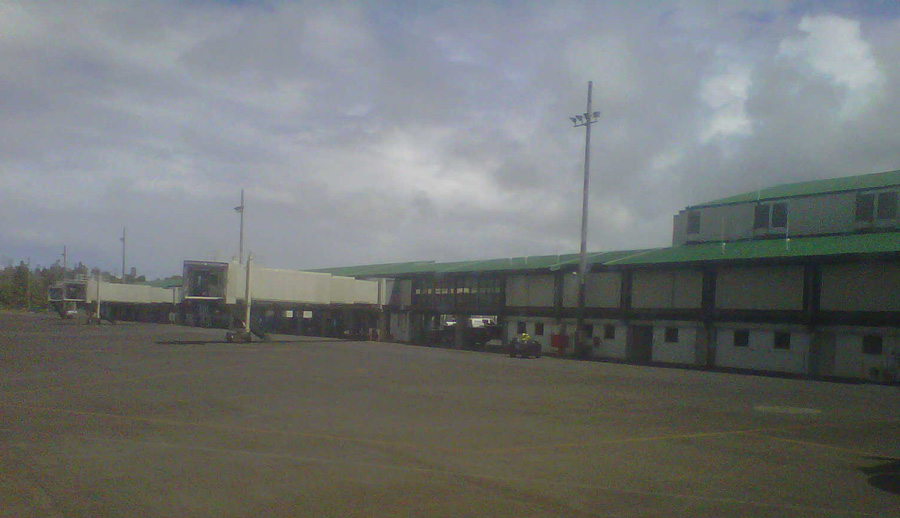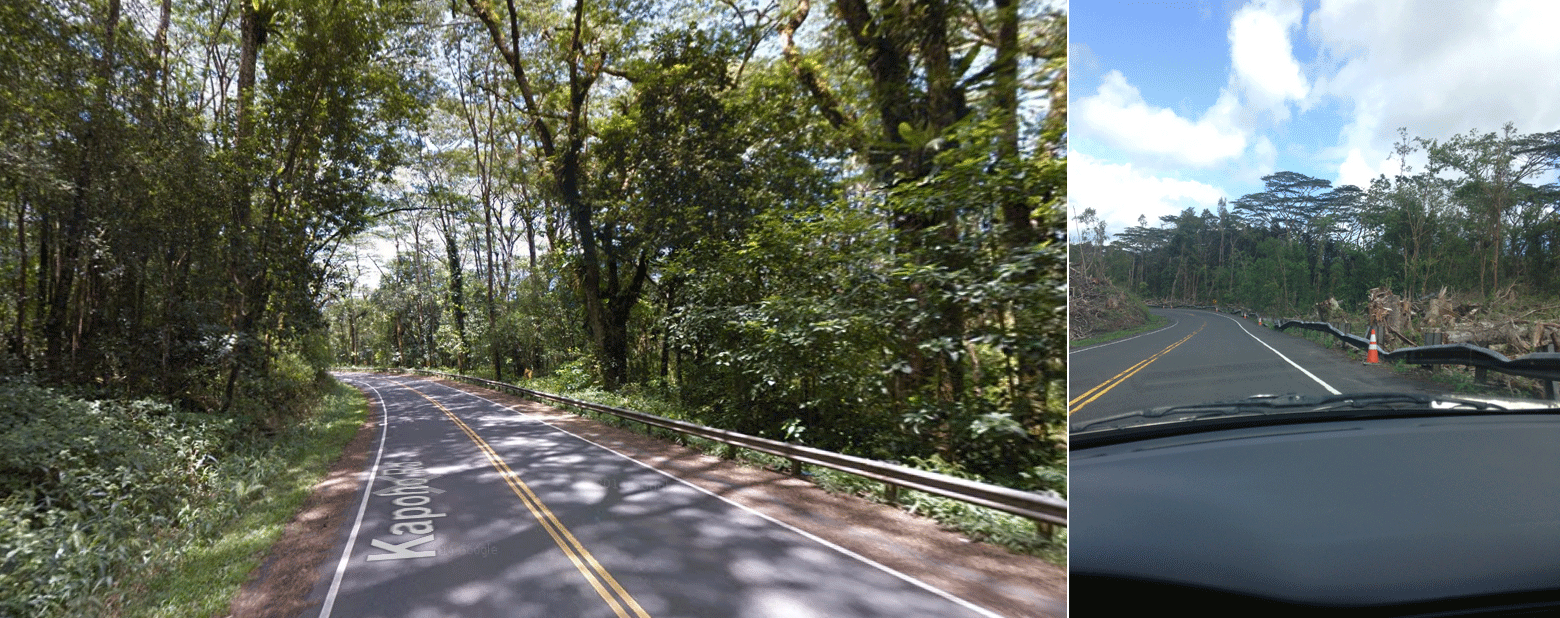A quiet breakfast – followed by a night time drive – as we begin Chasing Pele..
Chasing Pele #2: Rubicon Times
Our first night’s sleep was in a breezeless room. The air was humid, stagnant. Not a drop of rain fell upon the yard. It was too hot for even the grunting pigs to come out.
We were, however, granted a stunning sunrise, which pierced the bedroom around six. The day had begun and it was dry and hot. It was stunningly blue, and here and there a cumulus cloud held itself aloft in the vast open sky through magic and fabulousness.
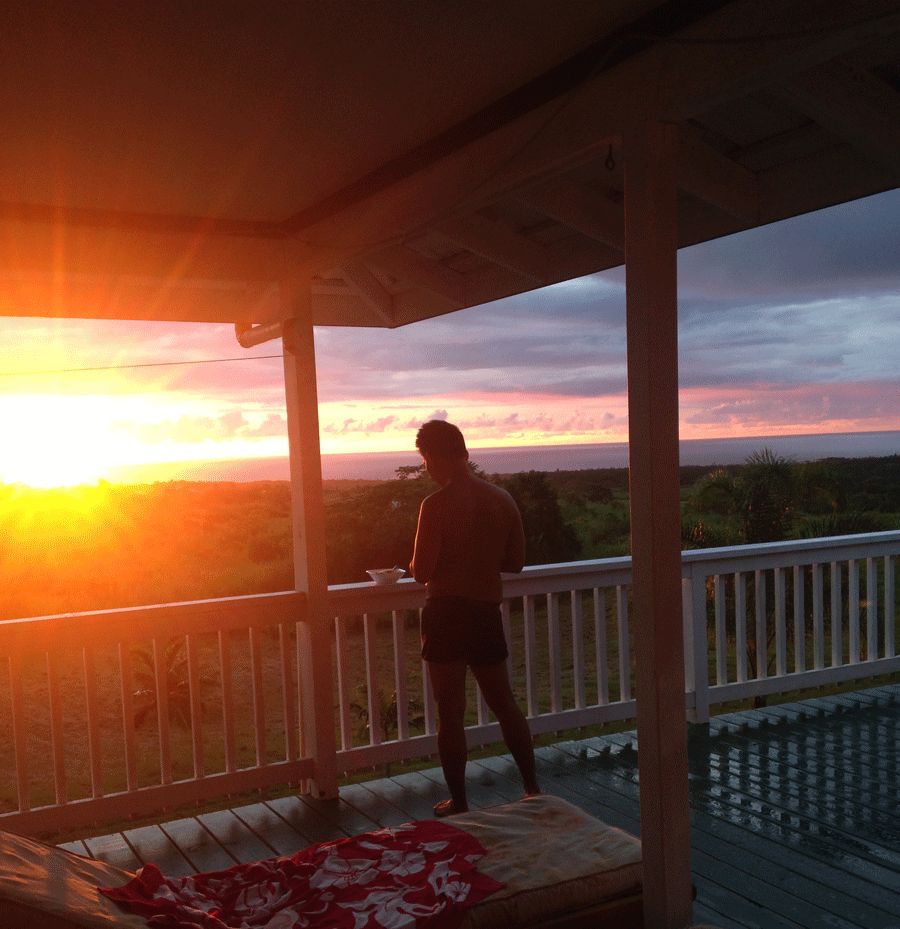
Lower Puna Sunrise, Oct 2014
Day One at the house is all about getting situated for the few weeks ahead, making sure you have clothes and toiletries pulled from storage and that your critical needs are on hand: food stuffs for at least a couple lunches and dinners, along with other mandatories such as coffee, yogurt, papaya, vodka, wine…
Aside from grocery shopping, on Day One I don’t like to do anything except acclimate to being back: no extensive yard work or chores; no To Do list creation (the must-do’s will easily sprout over and over like weeds, so there’s no harm in waiting a day to start filling up a list). A little preparatory cleanup around the yard is fine. The goal of Day One is preparation and reimmersion.
There was no coffee in the house. No milk. No nothing except the spices and oils on the cupboard. We’d skipped our grocery trip the night before purely out of fatigue and the desire to be at home and motionless. So we decided to head into Pahoa to buy our bits and eke out a sense of the mood in town.
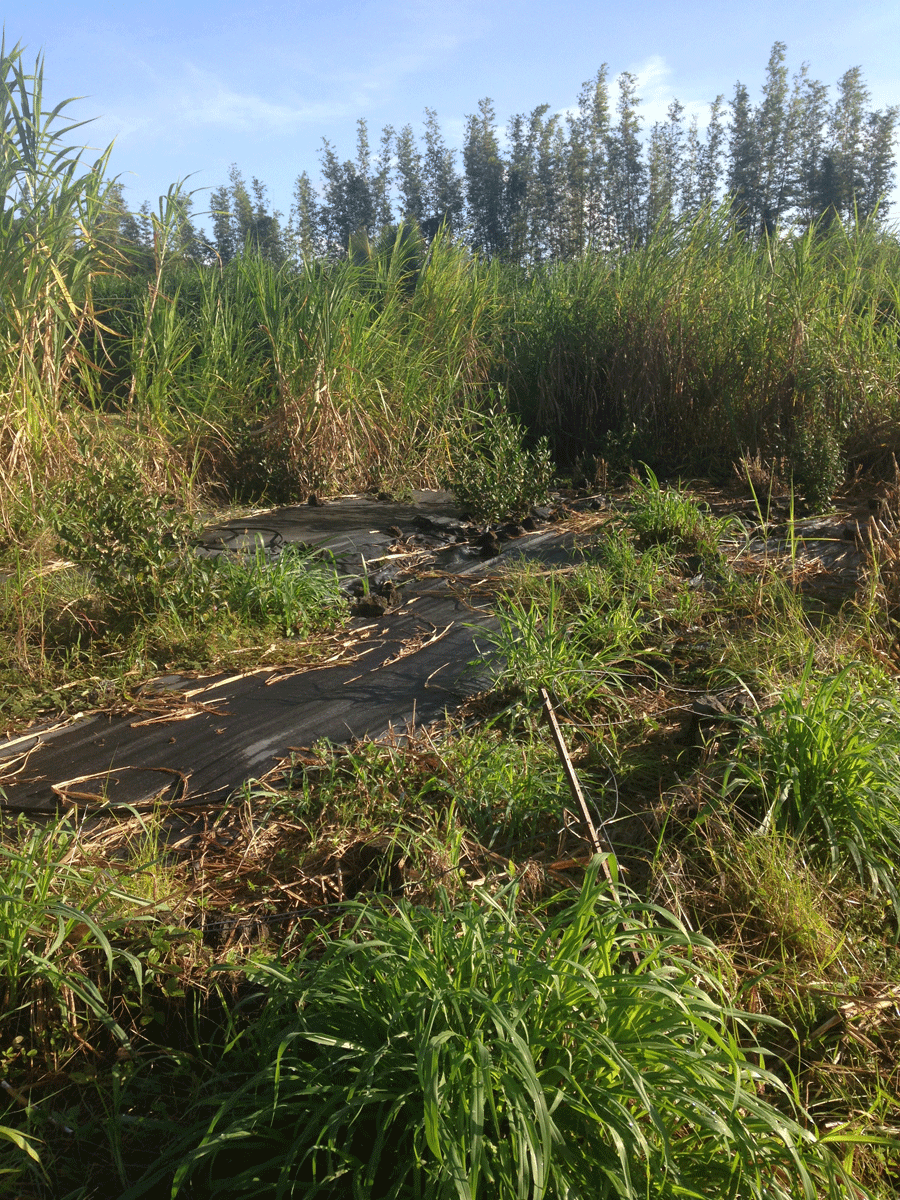
Tea bed Oct 2014
As I stood on the grassy lawn looking at the weeds twining their way up into the brakes on the car, I noticed what was missing that morning was the scent of grass and greenery being blown in by the trade winds. The air was utterly still. It felt like the planet had stopped hurling through space at 67,000 miles per hour and had come to a standstill.
Of course I knew that wasn’t true. I knew we were still in flight because when I was very young I asked my mother what would happen if the earth stopped spinning on it axis and she said we’d all die. (I presumed the same of making orbit around the sun.) Then I asked her when the world would end and she replied, “When everyone believes in Jesus.”
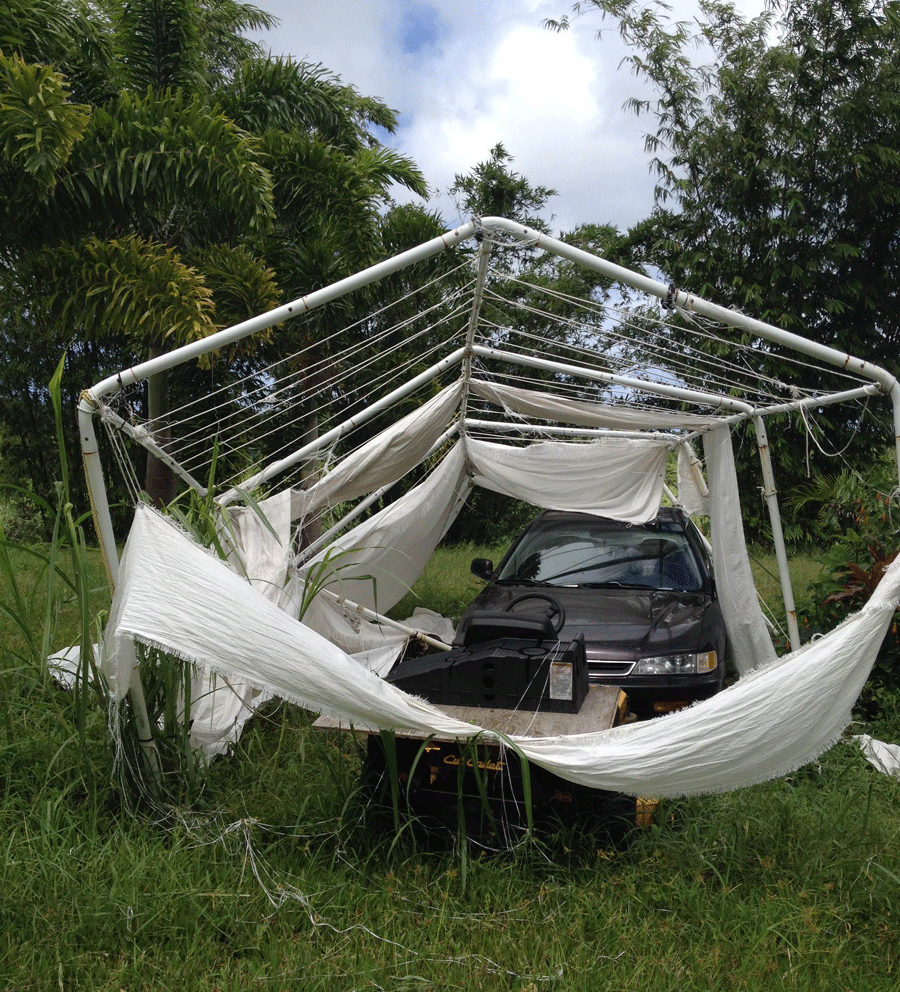
The carport tent, post-Iselle
At the back end of what used to be the carport is a hill. Five clusters of 20-foot tall bamboo stand like sentries on the hillside, providing some blockage against the full force of the trade winds. Down below the hill is the field, which was unkempt and growing wild with wickedly tall cane grass. In one corner of the field is our test tea bed; it too looked as if it had been consumed by the jungle.
After six months of being away from the house, all I wanted was one day of nothing, a day of reclamation: breakfast, farmers market, grocery, then to rest my lazy bones in the hammock for a while…
I yanked the vines and weed grasses away from the underneath of the car. I was annoyed with the condition of the tea bed and frustrated by the state of the field. I gave a disgruntled look to the yard and then at the cause of it all: our expensive lawn mower, which sat nearby under a brown tarp, out of commission.
Puna gives in many different ways, not all of them joyous: this time it was the car.
As I backed Arvin’s Honda out the remnants of the carport, the front brakes shuttered. Spasmed. It felt like the whole front end was going to snap off. AAA doesn’t do house calls in these parts, so I figured I’d try to drive off the brake noise and hopefully be able to chock it up to lethargy and under-use.
The shuttering did stop once we got moving down the driveway and along the denuded Pahoa-Kapoho Road. When we came to rest across the street from Luquin’s, the Mexican restaurant, the brakes were performing normally. Arvin got out and inspected the tires as a precaution. The front ones were clearly low on air and all four exhibited signs of cracking around the wheel.
Coffee, chilaquiles and a set of Bridgestones
Luqin’s restaurant is in Pahoa village – let’s call it “old” Pahoa. There we had coffee and breakfast, and had the place nearly to ourselves.
The tire shop, which also does vehicle inspections and other maintenance, is in “new” Pahoa, along with the grocery store, drugstore/pharmacy, hardware store, fish market, the new fire and police stations and (regrettably) a Burger King.
After breakfast we drove the half mile or so from old Pahoa into new Pahoa and got a new set of tires. At some point in the (near? very near?) future, this convenience will turn into a 75 mile trek.
Rubicon times
What separates old and new Pahoa is what the geologists call a path of steepest descent (the blue lines on the image below).
Click image to expand…
Pahoehoe lava flows are slow moving ribbons of lava whose motion is governed to a large extent by fluid dynamics. Their direction and their speed are influenced by topography.
In due time, the slow-moving lava will roll down these lines of steepest descent, filling in the low lying land while building up ridges around which the lava can spread as it continues inching forward, always widening. They tend to start as narrow fingers and progress into wider flows.
Back in early September, when the Pahoa flow was moving quickly out of a crack structure towards a neighborhood above town called Kaohe Homesteads, people flocked into Pahoa for what they figured would be their last supper at the town’s few restaurants. At the time no one had any idea when the flow would hit. The consensus among residents was that the lava was heading for town like a wide-bodied train.
With the lava due to hit Village Road at the end of September and then the Highway perhaps a week later, the realm of the familiar was running out. Lava was our Rubicon, and everyone on this side of the flow would have to choose in relatively short order whether to cross it into a strange new world or stay behind in what was bound to be an even stranger one.
In those first fews, the rumor mill had begun: who was staying, who was leaving, when would supplies stop coming…Everyone become a lava flow expert. A couple of businesses shuttered and left; the majority proudly if cautiously asserted, “We’re staying.”
The initial projections are that the current path of steepest descent which the lava is following will take it past or on top of our transfer station (a beautiful, recently completed $5m structure where we take our trash and recyclables), then through the sparsely populated region between old and new Pahoa.
Residents along the blue line are clearly going to lose their homes. One house along the Village Road has been over-optimistically put on the market for sale; another family across the street from that has parked a shipping container out front to fill and be ready to evacuate.
From this ‘middle town’, the flow is expected to continue onward across the highway and all the way down to the ocean. In order to do that, it will have to pass through the Hawaiian Beaches neighborhood, home to over 4,000 people.
Beyond the loss of homes and communities along the path of the lava, what makes the Pahoa flow unique is that the flow is poised to completely cut off Lower Puna’s other 5,000 residents from the rest of the island.
There is one road in and out of Puna right now: Highway 130. As you can see from my sketch above and the USGS map further up, the lava is heading towards the Highway. It was projected to hit early October, but with the changes in speed and volume that timeframe keeps changing.
In the meantime, the County is preparing alternate routes in and out of Puna. A couple miles makai (toward the ocean) runs Railroad Ave, an unused, unfinished old road that the County has recently graded and cindered. When the Highway gets taken out, gravel-topped Railroad will be our primary means of ingress and exgress.
Closer to the ocean lies the old Government Beach Road, a one-lane dirt road with turnouts. This rough stretch of road will be used for evacuation when or if Railroad Avenue gets taken out. (Based on projections and history of the Pu’u O’o lava flow, the more likely word is “when”.)
No way out…?
At every gathering we’ve been to during the past couple weeks, the dominant topic of conversation is the lava flow (unless it’s hurricanes approaching). The panicked sense of imminent doom has been supplanted by fatigue of waiting for the slow-motion devastation to play out. At dinner the other night, a friend remarked, “Just get here, for crying out loud. Take something.”
As much as nobody wants it to happen, we do live on an active volcano. For 31 years, the lava has been flowing primarily to the south – a manageable state of affairs. Now that the flow has shifted north, we’re entering a new state of normal.
Meanwhile, we wait.
Chasing Pele #1
Oct 4, 2014 – Saturday
HNL, inter-island terminal
I can’t see clearly now…
It’s a rare occasion you get to fly out of San Francisco with absolute clarity.
Saturday was such a day: weather-wise perfect, Indian Summer, hot cloudless skies.
The pilot was a kind creature who flew the A330 out of SFO via the scenic route. Those on the left of the plane got shimmering views of the City, while those on the right were afforded masterful views of the Golden Gate and beyond.
Ditto the arrival in Honolulu: sunny skies, clouds perched over the midland mountain range, where housing communities cascade down the valleys like lava flows.
By contrast, my mood upon departure and arrival was a medley of fatigue and anxiety from things past and present (drought, a hurricane, the novelist’s due ) and things unknown (the vicissitudes of work and an encroaching lava flow).
“Feeling misanthropic. Sick of airports and screaming children. Sick of the crowds. Sick of the same TSA announcements played over and over at every airport. Ebola. ISIS. Ritalin riddled, maladjusted kids with firearms in their desks back at home tromping through public in pre-explosive gaits, some future jeopardy awaiting them and all the rest of us at some perilous juncture.
I’m sick of Starbucks and Pumpkin spiced lattes (in paradise??), especially those brought to you by the over-extended brand of Oprah Winfrey.
Sick of families who think the world is their living room. A word of warning: the next three year old that shrieks at the peak of her ear-splitting lungs without a reprimand from its parents will make a handy sacrifice to Pele.”
Not a pretty frame of mind at the gateway to our Paradise.
Born to be…[?]
When I first met my physician he asked what I did for a living. I told him I was a writer. He looked over his reading glasses and then gently rolled his eyes: “Born to be unhappy.”
He explained that he lived with a writer for almost twenty years and it ended some time ago – for the better, I assumed.
(Years ago my mother offered up a similar, if less overtly stabbing, observation: “You used to be such a happy child; you were the happiest baby…”)
Perhaps I’m a nasty old codger and all these years of what I thought were gainful self-awareness were actually a fiction of the delusional sort.
Born to be unhappy. Did he write that on my chart, I wonder?
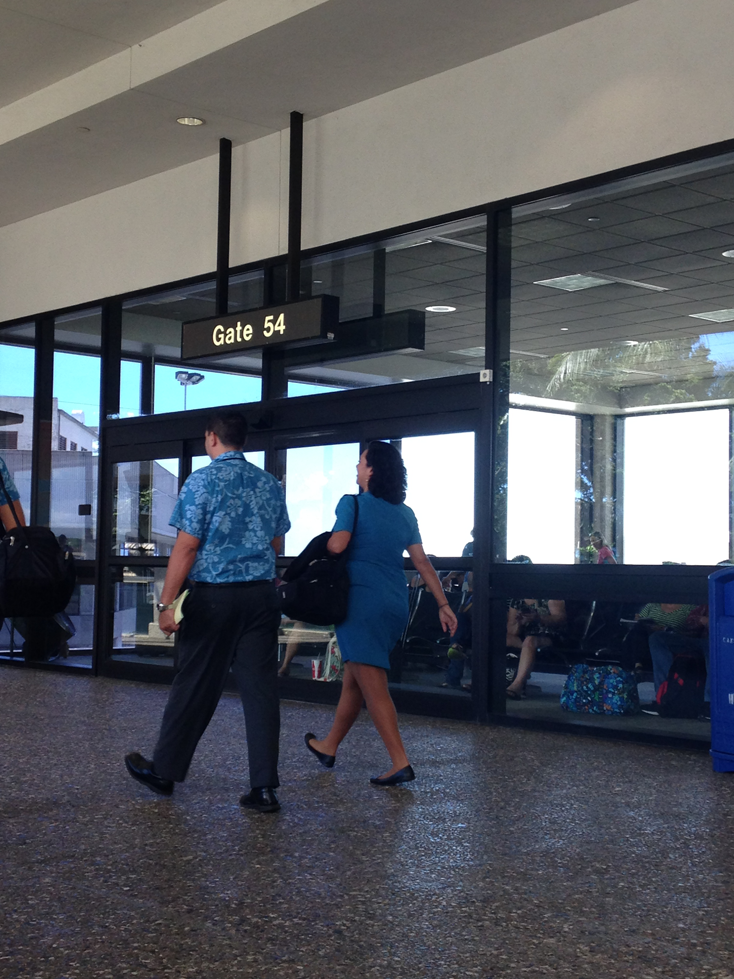
HNL Gate 54
It’s true, we’re a difficult audience. Difficult to live under a roof with. Difficult on ourselves. Especially those of us who were raised on the cheap white bread of country club romanticism. I think it’s because there’s some perilous perch between reality and romanticism that writers are compelled to hang out upon. To try and navigate. Which we do clumsily, ineffectively.
Hawaii is kind of like that. Puna, at least. Our Puna: the Lower Puna District. Puna is sort of like that perch in between reality and romanticism. It is very much a real place but it’s also subject to romanticized notions and pre-conceptions because it’s located in Hawaii.
We work from Puna, and when mainlanders on a conference call find out where I am and all chuckle and joke that I must be down at the beach drinking mai tais I kind of laugh it off and let them know that the beach is a solid two hours away.
Oh, and on top of that…
Four more hours to Truthville
The inter-island terminal at HNL was packed with people. The poor servers at the Stinger Ray’s restaurant by gate 57 were running non-stop. Despite the crowd we snagged a table at the fake outdoor patio and I secured my ritual usual: a kahlua pork sandwich and a tall Longboard ale.
Top of mind was, of course, the lava flow. The US Geological Service calls it the June 27th Breakout because that’s the date the flow went rogue and started heading northeast towards the Kaohe Homesteads and Pahoa town. Because of its first target, I prefer to call it the Pahoa Flow.
Since late August we’ve been tracking its progress daily through the USGS website, the Facebook pages of our Puna ‘ohana, and Big Island Video News. It’s pretty much assured that within the near future, the Highway to Hilo and potentially a newly graded alternate route (Railroad Ave) will be overtaken by lava, effectively locking in lower Puna. (More on that here.)
The slow-moving, three hour layover at HNL was made all the longer by lava anxiety. Now that we were on Hawaiian soil, the reality of the coming flow was becoming tangible, much less an academic discussion from 2500 miles away. It made for restless waiting for the fifty minute flight to Hilo.
Take me home…
4:30pm. We arrived in Hilo to grey skies and intermittent sprinkles. Our modest airport, which on the busiest day seems lonely, looked in a state of mild neglect. The planters of anthuriums that normally line the terminal hallway upstairs along the gates were gone: empty shells. Reconstruction of a doorway or stairwell was incomplete, covered by tarp and tape and left there as a bemusement.
A neighbor picked us up and we drove the 30 minutes to Lower Puna getting caught up on things lava and otherwise. The grand entryway to our neighborhood used to be a mile-long stretch of road canopied by striking, airy acacia trees, which formed a sort of tunnel, like a secret passageway. At the end of the tunnel the sky opened up and the road forked and that acted as a topographical welcome sign: there was only the last brief leg of the journey ahead before arriving at the gate to our communal road.
That was before Iselle.
The hurricane hit our neighborhood dead-on. Though many houses were damaged, the most visible impact was to the abundant albizia trees that used to rise above Lower Puna like graceful giants.
A huge number of them fell during the storm. Albizias are an acacia with a very shallow root system, trunks that grow easily up to 6 feet wide, and they rise to 70 feet tall or more. From time to time a big one would fall; more often, they’d drop limbs on the driveway or roads. At night, during rains, we’d often hear a “crunch” in the forest: another limb down. This time, though, the trees came down en masse.
The ones that didn’t come down along Pahoa-Kapoho Road were chainsawed by the County, leaving our once canopied sanctuary wide open to Jesus, the sky and everything else.
During the last stretch of the journey home, the discussion turned away from the lava and onto Iselle. It was as if we’d forgotten there’d been a tropical storm. (Truth is, we’d seen footage of the road and were deeply curious what our albizia-free Puna now looked like.)
The landmarks leading up to the driveway were all gone, one of them having smashed the gate in fact. Along the drive, the remnants of the nearly dozen trees that had fallen lay severed in the jungle.
We had an early dinner with the neighbors that night : wild sheep, sautéed amaranth greens, and a salad. A glass and a half of prosecco and a glass of red. A regaling of the howling winds and crashing trees during Iselle.
9:00 arrived. One half of the couple said to me : “You guys need to go. You’re tired.”
Indeed.
Puna midnight had hit hard. The day was pau.
